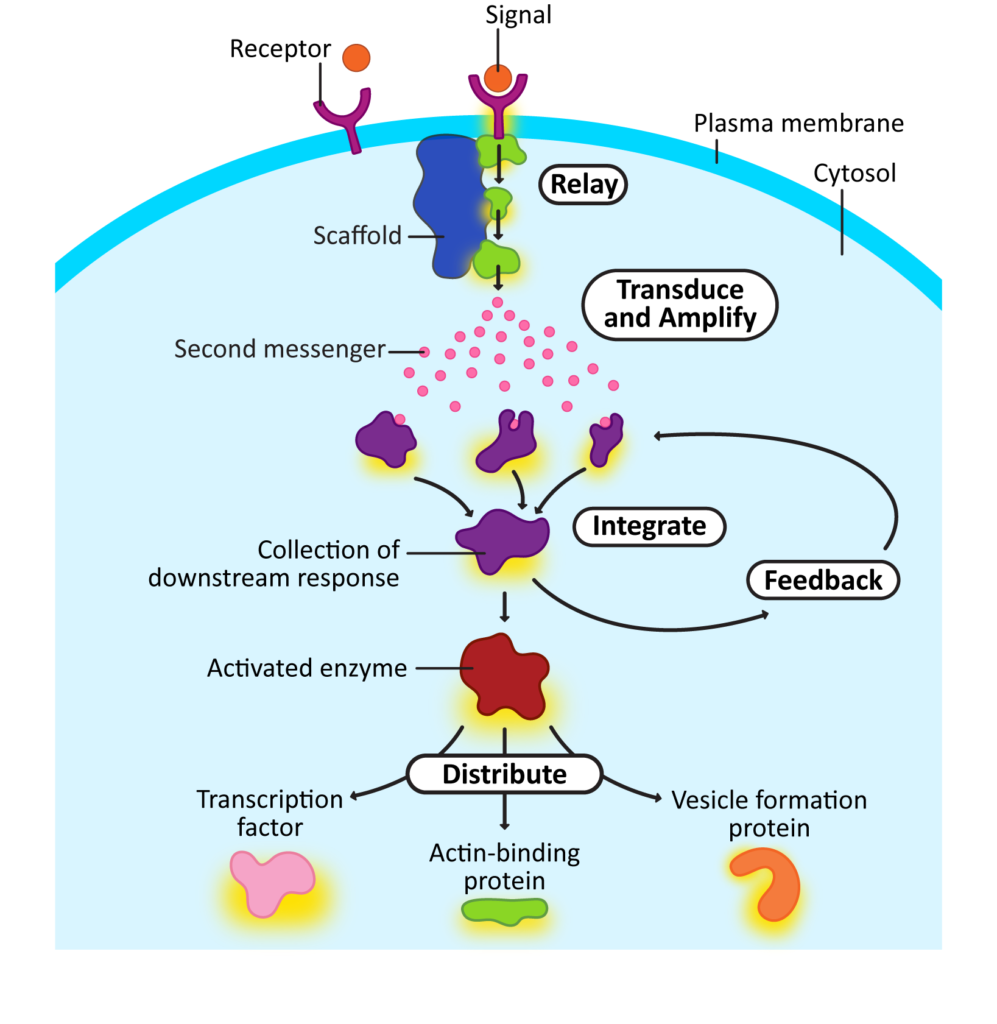Introduction of General Principles of Cell Signaling
Cell signaling is a fundamental process that allows cells to communicate with each other and coordinate their responses to environmental stimuli. It is essential for maintaining homeostasis, regulating cellular functions, and enabling multicellular organisms to function efficiently. The signaling mechanisms involve the detection of signals, transmission of information across membranes, and initiation of intracellular responses. This article explores the general principles of cell signaling, including types of signaling, key components, signaling pathways, and the role of second messengers.

Types of Cell Signaling
Cell signaling can be classified based on the distance between the signaling and target cells:
- Autocrine Signaling: A cell releases signaling molecules that bind to receptors on its own surface, leading to self-regulation. This type of signaling is common in immune responses and cancer cell proliferation.
- Paracrine Signaling: Signaling molecules act on nearby cells within a localized area. This mechanism is observed in neurotransmission and tissue repair.
- Endocrine Signaling: Hormones are released into the bloodstream and travel to distant target cells. Examples include insulin regulating glucose metabolism and thyroid hormones controlling metabolism.
- Juxtacrine Signaling: Signaling occurs through direct cell-to-cell contact via membrane-bound ligands and receptors. This plays a role in immune responses and development.
- Synaptic Signaling: A specialized form of paracrine signaling where neurons release neurotransmitters at synaptic junctions, facilitating rapid communication.
Key Components of Cell Signaling
Cell signaling involves several key components that work together to relay and amplify signals:
- Signaling Molecules (Ligands): These can be proteins, peptides, lipids, gases, or small organic molecules that bind to receptors. Examples include growth factors, neurotransmitters, and cytokines.
- Receptors: These are proteins on the cell surface or within the cell that recognize and bind ligands. Receptors are categorized into:
- G-protein coupled receptors (GPCRs): Mediate responses to hormones, neurotransmitters, and sensory stimuli.Receptor tyrosine kinases (RTKs): Involved in growth factor signaling and cell proliferation.Ion channel receptors: Facilitate ion flux across membranes, essential for nerve impulse transmission.
- Intracellular receptors: Located in the cytoplasm or nucleus, responding to lipid-soluble ligands like steroid hormones.
- Intracellular Signaling Pathways: A cascade of molecular interactions that amplify and propagate signals. These pathways often involve protein kinases, phosphatases, and secondary messengers.
- Effector Proteins: Execute the final cellular response, which may involve changes in gene expression, metabolism, or cytoskeletal dynamics.
Signaling Pathways
Several major signaling pathways regulate cellular functions:
1. G-Protein Coupled Receptor (GPCR) Pathway: GPCRs are the largest family of cell surface receptors. Upon ligand binding, GPCRs activate heterotrimeric G-proteins (Gα, Gβ, Gγ), which regulate downstream effectors such as adenylyl cyclase, phospholipase C, and ion channels. The activation of second messengers such as cyclic AMP (cAMP) and inositol triphosphate (IP3) leads to a cellular response.
2. Receptor Tyrosine Kinase (RTK) Pathway: RTKs play a crucial role in cell growth and differentiation. Ligand binding induces receptor dimerization and autophosphorylation, activating downstream signaling proteins such as the Ras-MAPK pathway and the PI3K-AKT pathway, which regulate gene transcription and cell survival.
3. Notch Signaling Pathway: This juxtacrine signaling pathway is essential for cell differentiation. Ligand binding induces cleavage of the Notch receptor, releasing the Notch intracellular domain (NICD), which translocates to the nucleus and regulates gene expression.
4. Wnt/β-Catenin Pathway: In the absence of Wnt ligands, β-catenin is degraded. When Wnt binds to Frizzled receptors, β-catenin accumulates and enters the nucleus to modulate gene transcription. This pathway is crucial for embryonic development and tissue homeostasis.
5. Hedgehog Signaling Pathway: Hedgehog proteins bind to the Patched receptor, leading to activation of the Smoothened protein, which regulates transcription factors like Gli. This pathway is essential for embryogenesis and tissue regeneration.
Role of Second Messengers
Second messengers amplify and distribute signals inside the cell. Major second messengers include:
- Cyclic AMP (cAMP): Generated by adenylyl cyclase, it activates protein kinase A (PKA) to regulate metabolic pathways.
- Calcium Ions (Ca²⁺): Released from the endoplasmic reticulum via IP3, it regulates muscle contraction, neurotransmitter release, and enzyme activation.
- Diacylglycerol (DAG) and Inositol Triphosphate (IP3): Produced by phospholipase C, DAG activates protein kinase C (PKC), while IP3 triggers Ca²⁺ release.
Regulation of Cell Signaling
Cell signaling is tightly regulated to ensure proper function and prevent pathological conditions:
- Feedback Mechanisms: Positive and negative feedback loops modulate signal intensity and duration.
- Signal Desensitization: Prolonged exposure to a ligand can lead to receptor desensitization, preventing overstimulation.
- Protein Degradation: Ubiquitin-mediated degradation of signaling proteins ensures transient signaling.
- Compartmentalization: Signaling components are localized in specific cellular regions to enhance efficiency.
Conclusion
Cell signaling is a complex and dynamic process that governs numerous physiological functions. Understanding the principles of cell signaling is crucial for biomedical research and drug development, as dysregulation of signaling pathways is implicated in diseases such as cancer, diabetes, and neurodegenerative disorders. Advances in molecular biology and bioinformatics continue to unravel the intricacies of cellular communication, paving the way for targeted therapies and precision medicine.
Visit to: Pharmacareerinsider.com


1 thought on “General principles of cell signaling”